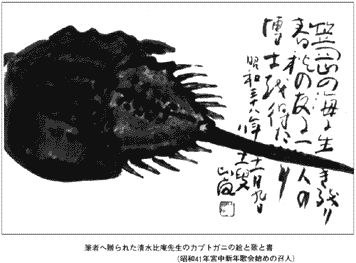
Have continued to survive in the Kasoka waters
Spring and Autumn a friend
A learned person gently comes, steps carefully.
Introduction
In Japan, the horseshoe crab (Kabutogani) has long been legendary. In ages past brave warriors who honorably sacrificed their lives in battle were said to be reborn as horseshoe crabs, their shells samurai helmets, eternally crossing the bottom of the sea. On brush-painted rice paper screens, through calligraphic versions of haiku, their attributes were succinctly sung. Yet here, where the Delaware Bay and its 140 miles of uninterrupted beaches remain the horseshoe crab's central habitat and breeding grounds, Limulus polyphemus, the species that lives in Atlantic coastal waters, rarely appears in literature or art.
What lies behind our reluctance to embrace the horseshoe crab as a creature to be treasured and valued? For much of the past century the horseshoe crab was used as fertilizer for farms and driven nearly extinct by over-fishing. At the end of the twentieth century, Limulus polyphemus finds itself at the center of a tug of war-- of interest to commercial fishermen as bait for conch and eels; to birders as a source of eggs for migrating shorebirds; to biomedical companies for the clotting and antibacterial capacity of its blood.
This ancient mariner's ancestral lineage stretches back nearly 400 million years, yet its future remains uncertain. Indeed, the survival of this species into the next century hinges on the human capacity to govern our greed and give sanctuary on our shores. Let us hearken to a new day when we protect the unseen realms beneath our waters through our science and sing of Limulus polyphemus with our art.
Lisa Garrison